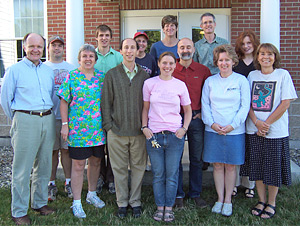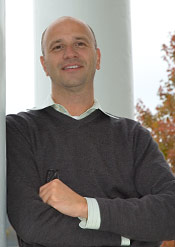Currents: faculty orientation
College Orientation: It's Not Just for Students Anymore

Just as first-year students became acquainted with Colby-Sawyer College through Student Orientation before classes began, the college's 10 new full-time faculty members were initiated into their teaching roles here through the New Faculty Learning Community: Orientation Program in late August.
While these incoming full-time faculty bring impressive academic credentials and a range of teaching experience to their positions, they often need assistance in adapting to a new environment, just as students do. Faculty members from five academic departments took part in four days of discussion and workshops, which included broad overviews of the college from its leadership, lessons from the established faculty, and students' perspectives on the most effective ways of teaching and learning.
The faculty orientation began with introductions to each other and to President Tom Galligan and Academic Vice president Deborah Taylor. Similar to students in orientation, the faculty also engaged in hands-on learning with the college's technology systems--from the campus computer network and Exchange e-mail system to Blackboard classroom management programs, Smart Classrooms, IQ Web and the library's online resources.
Vice President Taylor conceived the orientation program in 2006 as a way of addressing common themes that arose and sometimes caused stress among new faculty. She believed that before they began creating their class syllabi and teaching, the new faculty needed a formal introduction to Colby-Sawyer's culture, policies, procedures and resources, as well as to its distinctive approach to teaching and learning.
“The small size of our classes and the level of interaction between faculty and students is very different from larger universities, where many of our new faculty are coming out of graduate school,” says Jean Eckrich, the facilitator of new faculty orientation. “We want them to understand the possibilities and the expectation for accessibility and close interaction with students, and be able to respond, within reason, to our students' needs. The faculty generally has a high presence on campus, and it sometimes requires another level of adjustment for new faculty members.”
Professor Eckrich, chair of the Exercise and Sport Sciences Department, took on the role of facilitator based on her experience and training in faculty development and teaching and learning techniques, which was the focus of her spring 2003 sabbatical as a faculty fellow with the American Association for Higher Education and of an international institute for new faculty developers that she attended in Ottowa last summer.
“One of the unique things about Colby-Sawyer is that our culture seeks to help our faculty be successful,” she says. “It's not seen as a weakness to seek help or advice or to admit when it's not going as well as you'd like in the classroom. We have very few turf battles here because we understand that we have limited resources and need to share ideas and strategies. That's really who we are: We share faculty across departments and do cross-disciplinary classes and proposals together.”
Sharing Lessons Learned
Three assistant professors who joined the college in the last five years—Nick Baer from Natural Sciences, Chris Kubik from Business Administration and Jen Austin from Exercise and Sport Sciences—took time to share some of the lessons they've learned in their time at Colby-Sawyer.

Professor Baer, who joined Colby-Sawyer in 2004, spoke with the new faculty about what he sees as the advantages of teaching at a small liberal arts college.
“Your colleagues within your department and across campus can be great resources for you as you develop your courses,” he says. “Faculty are very willing to share ideas across disciplines, and you can also take advantage of visiting other professors' classes as a way to spark new ways of teaching for you.”
Professor Baer also talked about the pleasures of multiple disciplines within the same department. “It leads to the sharing of ideas and approaches, such as quantitative literacy across campus,” he explains. “Another one of the pleasures of teaching at a small liberal arts college is that you get to watch the students develop over their four-year tenure at Colby-Sawyer. You have the opportunity to teach the same students multiple times.

Professor Kubik, who arrived at Colby-Sawyer in 2006, advised the new faculty to attend events on campus as a way of gaining perspective on students' lives outside of the classroom.
“I found that this helped me appreciate the students' various activities, their challenges in time management, and gave me an appreciation for students outside of how they perform in a particular class,” he says.
Professor Kubik also reminded faculty to “get outside” and generally make sure to strike a healthy balance in their lives, just as they would advise their own students to do.
“Just as we tell students there is more to learning than the classroom,” he adds, “faculty need time to reflect on and plan class time outside of the confines of the office where computers, phones and the like are constant temptations for busy work and can deprive us from time to creatively think about classes.”
New Faculty Weigh In
Aaron Major taught at Colby-Sawyer as an adjunct faculty member while completing his Ph.D. dissertation at New York University, and he has now joined the Social Sciences and Education Department as an assistant professor. While he already had a feel for the college's culture and had positive experiences with the faculty and students, he looked to the orientation program for insights into how others manage and present the material in their courses.
“The orientation was time well spent. We had a chance to meet a lot of other faculty, and it helped throw me into the college community,” he says. “I've adopted some of the other faculty's techniques such as focusing more course content on writing and research, and allowing students to do more workshopping on their writing in groups. I've also tried some simple new ideas, such as the way students introduce themselves to each other in class, which are working very well.”
Assistant Professor of Exercise and Sport Sciences Stacey Watts is one of the new faculty members who brings years of experience working closely with students as a coach, physical educator and athletic administrator. For her, orientation was a well-orchestrated immersion in a new environment that left her feeling welcomed and more connected.
“In my previous position, I was just handed the keys to my office and didn't receive a lot of guidance or direction,” says Professor Watts. “The orientation here was long, but worthwhile, as I personally gained much needed information and had the opportunity to make valuable connections with new and established faculty, staff and administrators.”
Professor Watts was also put at ease by other faculty members' willingness to share their own successes and difficulties in the classroom. “It's good to know that even experienced teachers face challenges,” she says.
She likes the smaller, co-educational environment at Colby-Sawyer and believes that her coaching experience has helped prepare her for teaching. “I approach teaching very much like coaching,” she says. “I'm here to coach the students through the material. As with coaching, it's a partnership with students.”
Professor Watts describes Colby-Sawyer as one of the most welcoming places she's ever been. “You meet people and they know your name when you see them on campus,” she says. “They tell you, 'If you need help, come see me.' I'm feeling very happy and healthy here.”
Susan Glasheen Reeves '88 is the new chair of the Nursing Department, but she's experienced the college before both as a student nurse and as the interim chair of her current department. While she didn't need to attend the entire orientation program, she made sure to be there for the introductions to the college's culture and the sessions on teaching and learning.
“My background is in nursing, so the faculty role is somewhat new to me,” says Professor Reeves. “Jean and the others helped the faculty with tried and true approaches to teaching and learning from the experts—what works and doesn't work so well—allowing for personal latitude but not so much as to allow you to fall into common mistakes.”
Professor Reeves found the sessions with the academic department chairs helpful to her both as a new chair and as a new faculty member. “It was a very supportive time in which each faculty member was able to see their department chair talking about how they support and nurture their faculty and make sure they're successful,” she says. “When I need to turn to someone for support, I know I will have many friends.”
One highlight of the orientation program was the group of students who came to speak to new faculty about the kinds of teaching environments, methods and styles that work best for them. “It's always good to hear from the 'customer,' to use my jargon,” says Professor Reeves. “I was pleased with the thoughtfulness of their preparation. The students took their roles very seriously.”
As an alumna returning to the college, and the very same department, where she enjoyed an extraordinary educational experience, Professor Reeves hopes to ensure that current and future nursing students will have similarly positive experiences. She came to Colby-Sawyer in 1981, as a married, non-traditional student, to participate in the college's RN to BSN program, in which registered nurses earn their bachelor's degrees, a program she'd like to see reinstated at Colby-Sawyer.
It took her seven years to complete her degree, as she juggled her marriage, her work as a nurse, and eventually, her first child, with her studies, but she describes her education as “truly outstanding.” “It truly surpassed any education that followed,” she says. “I was here with some of the legendary professors such as Jack Jensen, Larry Dufault, Kathy Springsteen, Wes McNair and Carol Haraden and Joe Carroll,” she recalls. “I have such great memories of my time here.”


